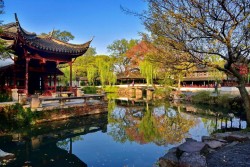You have no items in your shopping cart.


Introducing Suzhou Museum
Suzhou Museum is a cultural institution nestled in downtown Suzhou, opened in 1960. Suzhou Museum spans an impressive 26,500 square meters (6.55 acres), encompassing both a modern structure established in 2006 and the historic palace of King Zhong from the Taiping Heavenly Kingdom era (1851-1864).
The museum’s contemporary building, designed by the late Pritzker Prize-winning architect I.M. Pei (1917-2019) in 2006, is considered Pei’s swan song. Unlike his more avant-garde creations worldwide, this museum stands as his most quintessentially Chinese work, incorporating time-honored symbols and motifs throughout its structure. This masterful design has cemented the museum’s status as a beloved landmark in Suzhou.
Today, housing over 24,500 cultural relics, Suzhou Museum offers visitors a unique window into the city’s storied past. While it may not boast the vast collections of some global institutions, the museum distinguishes itself through its specialized focus on Suzhou’s cultural legacy. The carefully curated exhibits showcase a range of treasures, including archaeological finds, exquisite Ming (1368-1644) and Qing (1644-1912) dynasty paintings and calligraphy, and a variety of ancient arts and crafts.
Suzhou Museum Fast Facts
• Chinese Name: Suzhou Bowuguan 苏州博物馆
• Best Time to Visit: All year around
• Recommended Visiting Hours: 2 - 3 x hours
• Things to Do: Photography, Architecture, History and Culture
• Opening Hours: Tuesday to Sunday, 9:00-17:00
• Entrance Fee: Free
• Address: No. 204, Dongbei Street, Gusu District, Suzhou, Jiangsu Province
What to Expect at the Suzhou Museum
Suzhou’s 10,000-year history, from ancient settlement to Wu State capital 2,500 years ago, is showcased at the architecturally stunning museum. Exhibitions like “Wu Pagodas” and “Wu Treasures” immerse visitors in the city’s rich past, making it a must-see for history and architecture enthusiasts.
Ingenious Architectural Design
Renowned for his iconic designs around the world, I.M. Pei drew inspiration from the heart of Suzhou’s old city for this museum. Sloping roofs, a classic black, white, and gray palette, and traditional white stucco walls echo the city’s heritage. However, Pei infuses the design with a contemporary spirit through the use of glass within the roof, a steel structure replacing traditional wooden beams, and sleek “China black” granite roof tiles. This interplay of materials allows natural light to filter through the stone and glass roof, artfully regulated by metal sunshades.
Geometric precision further defines Pei’s vision. Octagons, rhombuses, and triangles form the building blocks of the museum’s design. The atrium and several halls embrace an octagonal shape, while rhombus-shaped windows punctuate the facade. Atop, the roofs and ceilings transform into a captivating patchwork of triangles, rectangles, and rhombuses, setting the structure apart from its traditional Suzhou neighbors.
Beyond the museum walls, Pei masterfully integrates the building into its surroundings through a series of courtyards. The central courtyard, a creative landscape garden, is embraced by the museum on three sides, while the north side opens to the renowned Humble Administrator’s Garden. This main courtyard, considered the most meticulously designed, features pebbled ponds, bridges both straight and winding, octagonal pavilions, and a tranquil bamboo forest. Through this harmonious blend of architecture and landscape, Suzhou Museum becomes a museum where the visitor experience is elevated to new heights.
Exhibition of Wu Pagodas
This exhibition offers a rare window into the sacred past of Suzhou, revealing Buddhist relics unearthed from two of its most famous landmarks: the magnificent Tiger Hill Pagoda (Yunyan Temple) and the ancient Ruiguang Pagoda near Panmen Gate. The carefully chosen artifacts and supporting relics invite visitors on an enchanting journey through time, bringing the city’s spiritual history to life.
Exhibition of Wu Treasures
Journey through time on the museum’s south side with an exhibition showcasing a diverse collection of relics. Begin with prehistoric pottery and trace the evolution of craftsmanship through intricate bronze and jade pieces from the Spring and Autumn period (770-476 BC). Marvel at exquisite celadon and porcelain, testaments to centuries of glazing mastery. And don’t forget to uncover the stories held within the burial objects, where ancient beliefs and daily life are revealed, offering a unique perspective on the past.
Exhibition of Wu Paintings and Calligraphy
During the Ming Dynasty, Suzhou flourished as a center of artistic innovation, attracting over 150 renowned painters and scholars who formed the Wu School. Their distinctive style, characterized by landscape paintings, quickly earned acclaim, cementing their legacy in painting history. This exhibition offers a rare glimpse into this pivotal period by showcasing the beauty and technical mastery of Wu School paintings and calligraphy.
How to Get to Suzhou Museum
• By Bus: Take bus 301 to Suzhou Bowuguan Station.
• By Subway: Take subway line 6 to Zhuozhengyuan Subo Station.
Additional travel advice on Suzhou Museum
• The museum is closed on Mondays except Chinese public holidays.
• Food and colored drinks are not allowed in the museum.